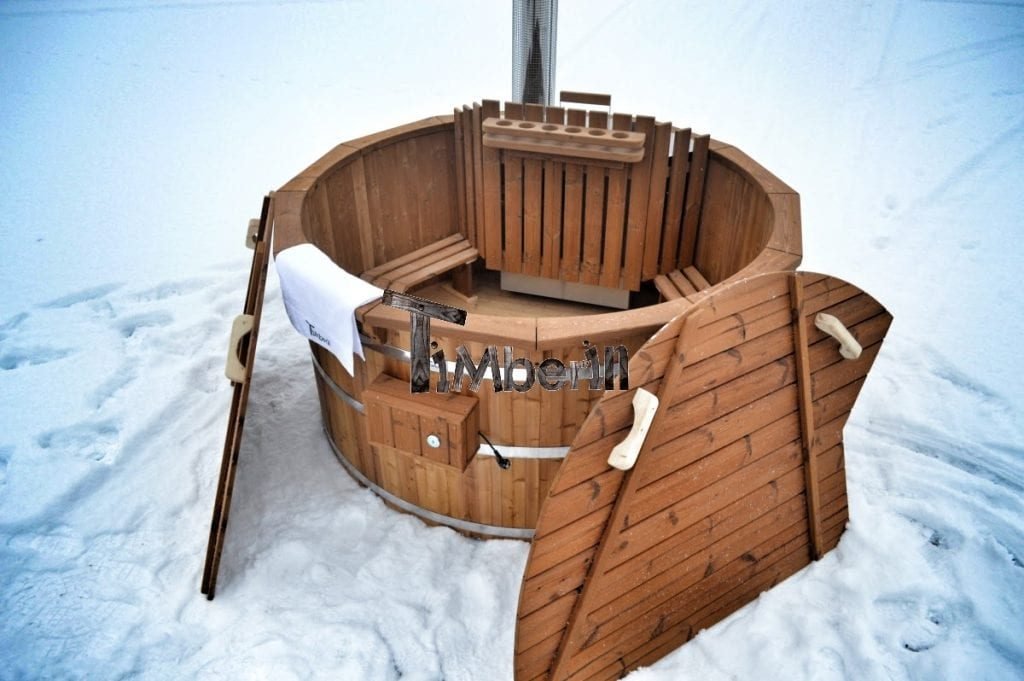Fully wooden, old school hot tubs are the true classic of the hot tub world. However, with all of their benefits, come a few shortcomings of the old world. As things like polypropylene, fiberglass and other similar man-made materials were not available at the time, wood was trusted to create the shell of the tub. The natural features of wood cause it to distort over time, as the moisture level around it fluctuates. This can often cause some issues, the main of which is without a doubt leaking water.
how to make wooden hot tub?
Making of a wooden hot tub includes the assembly of wooden planks for building walls, bottom and the lid. It should include a heating element: a wood-fired stove or an electric heater.
how to seal the wooden hot tub?
When facing this type of issue, hot tub manufacturers recommend two solutions. The first one is using simple sawdust to plug the leaks. This is done by taking some sawdust and adding a proportionately small amount of water to it. The sawdust must be finely mixed up with the water to turn it into a paste, which then can be easily applied to the leaking area. Before applying, make sure that the hot tub is full of water, and then try to push the paste into the leaks.
It would be disingenuine to imply that leaking is only ever caused by the natural factors of wood. Leaking can also be caused by extensive use of chemicals, flaws in the construction. In very unique cases, it can even be caused by a badly installed non-stable base, physical damage to the tub, or even biological causes (insect or other pest infestations).

Oftentimes, when purchased a wooden hot tub it is important to let the wood expand to its full saturation point, which in turn will close up any gaps that may be present. To help the wood expand, it must be kept in contact with water. This process can take up from a few days to a couple of weeks and depends on various variables such as wood type, climate conditions, etc. You will find pictures attached below of a test we‘ve done for one leaking hot tub. This should illustrate what kind of results should be expected.
In very limited cases, the wood expansion may still leave a few tiny leaks around the hot tub. When facing this type of issue, hot tub manufacturers recommend two solutions. The first one is using simple sawdust to plug the leaks. This is done by taking some sawdust and adding a proportionately small amount of water to it. The sawdust must be finely mixed up with the water to turn it into a paste, which then can be easily applied to the leaking area. Before applying, make sure that the hot tub is full of water, and then try to push the paste into the leaks. The force created by the existing water will draw the mashed-up sawdust into the leak, where it will expand causing the leak to be sealed.
The second option is using wood colored water-resistant silicone. It should be applied to a completely dry tub in the leaking area. Once it has hardened you may test it by filling the hot tub with water.
| Day № | Water loss (liters) | Water level reduction (cm) |
| 1 | 81 | 7.5 |
| 2 | 81 | 7.5 |
| 3 | 77 | 6.5 |
| 4 | 72 | 6.5 |
| 5 | 68 | 6 |
| 6 | 66 | 6 |
| 7 | 58 | 5.5 |
| 8 | 52 | 5 |
| 9 | 21 | 2 |
| 10 | 16 | 1,5 |
| 11 | 10 | 1 |
| 12 | 9 | 1 |
| 13 | 6 | 0,5 |
| 14 | 3 | 0,3 |
| 15 | 1 | 0,1 |




